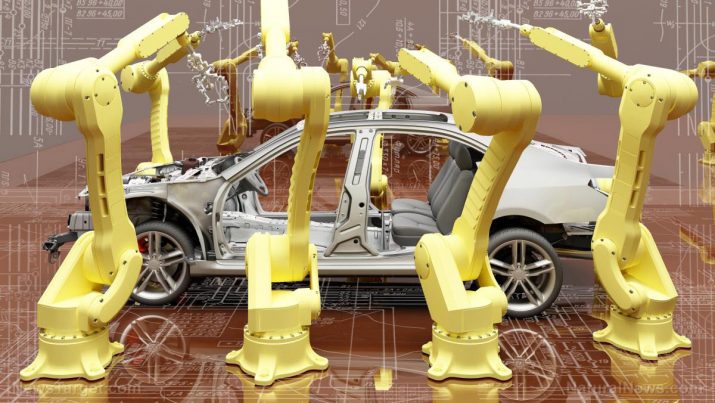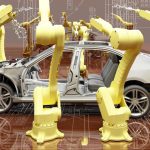
The robotic revolution: How China’s automation drive is leaving the West behind
Thursday, October 16, 2025 by Zoey Sky
http://www.progress.news/2025-10-16-robotic-revolution-china-automation-leaving-west-behind.html

- China has opened a massive lead in automation, creating a widening technological gap that shocked Western business leaders.
- This automation revolution is state-backed and strategic, driven by government initiatives like “Made in China 2025” and subsidies for companies to buy robots. The goals are to maintain manufacturing dominance despite an aging population and to lead in high-value sectors like electric vehicles and robotics.
- The scale of China’s robot adoption is staggering. As of 2024, China has installed over two million industrial robots.
- This robotic dominance is already impacting global markets. Chinese companies, particularly in the electric vehicle sector, can develop and produce cars much faster and cheaper than Western competitors, allowing them to rapidly capture market share.
- Western nations, especially the U.K., are falling dangerously behind. The U.K. has a very low rate of robot adoption, and new installations are declining. Experts warn that failing to automate will not protect jobs but will instead destroy them, as industries become uncompetitive and work moves to more efficient, automated countries.
A quiet, profound shock is rippling through the upper echelons of Western industry. Chief executives and business leaders returning from fact-finding missions to China are bringing back a consistent, unsettling report: The technological gap is not closing, it’s widening at an alarming pace.
The source of their unease is not just cheap labor, but something far more transformative and formidable: a sweeping, state-backed revolution in robotics and automation that has catapulted Beijing into a dominant position in global manufacturing. The anecdotes from these visits read like dispatches from the future. Andrew Forrest, the Australian billionaire behind Fortescue, described walking alongside a massive conveyor belt in a Chinese factory.
Machines emerged from the floor to assemble parts, and hundreds of meters later, a finished truck drove out. The most striking feature? “There are no people,” noted Forrest. Everything is robotic.
Other executives speak of vast “dark factories” – facilities so heavily automated that there is no need for lighting for human workers. Greg Jackson of Octopus Energy recalled visiting one such plant producing an “astronomical number” of mobile phones.
The manufacturing side was entirely handled by machines, with only a skeleton crew present for maintenance. This, Jackson observed, marks a fundamental shift where China’s competitiveness has evolved from being about subsidies and low wages to a surge of highly skilled engineers driving relentless innovation.
This high-tech transformation represents a dramatic departure from the “Made in China” label long associated with low-cost, low-quality goods. Today, China is a recognized leader in high-value sectors like electric vehicles (EVs), batteries, solar panels and advanced robotics. This metamorphosis is underpinned by an obsessive national focus on automation, actively encouraged and subsidized by the government.
The numbers are staggering. According to the International Federation of Robotics (IFR), China has deployed over two million industrial robots as of 2024, a monumental leap from just 189,000 a decade ago. To put this in perspective, China installed 295,000 new robots last year alone – more than the United States (34,000), Germany (27,000) and the United Kingdom (a mere 2,500) combined.
The lead isn’t just about scale. In robot density, a key measure of automation penetration, China now boasts 567 robots for every 10,000 manufacturing workers – significantly outpacing Germany (449), the U.S. (307) and the U.K. (104).
From workshop to powerhouse: The strategy behind the silicon workforce
While boosting productivity is a universal goal, analysts point to deeper strategic drivers for Beijing’s automation push. Rian Whitton of Bismarck Analysis explains that alongside a desire to dominate future industries, China is proactively using robots to mitigate the impact of its rapidly aging population.
With a looming demographic problem and a traditionally labor-intensive manufacturing base, automation is seen as a necessary compensation, a way to maintain and even extend its competitive advantage. This policy is formalized under initiatives like “Made in China 2025” and a specific strategy known as “jiqi huanren,” literally, “replacing humans with machines.” Local authorities often reimburse firms for a significant portion of their spending on industrial robots, creating a powerful financial incentive to automate.
The real-world impact of this robotic dominance is now being felt in Western markets, most visibly on the roads. Chinese-made electric vehicles, praised for their low prices and well-appointed interiors, are capturing growing market share. In Britain, for instance, the Chinese automaker BYD saw its sales multiply tenfold in a single month, overtaking established European brands.
The speed of development is a key differentiator. Industry experts note that Chinese carmakers can develop and launch new models in roughly half the time it takes their European counterparts, an agility made possible by hyper-efficient, automated production lines.
The warning from experts like Sander Tordoir of the Centre for European Reform is stark. Europe and Britain must urgently boost their own deployment of robotics to keep pace.
The stakes are twofold. First, robotics are crucial for lifting productivity, a vital concern for ageing Western economies. Second, the sector has significant spillover effects into the military-industrial complex, making China’s lead a matter of economic and national security.
The peril of falling behind
The U.K., however, is moving in the wrong direction. Its record on robot adoption is already poor, with less than half the robot density of France. Alarmingly, the number of new robots installed in the U.K. last year fell by 35 percent.
The tendency, experts warn, is for politicians to protect aging factories in legacy industries instead of fostering the high-tech jobs of the future. The consequence of this inertia is not the preservation of employment, but its eventual destruction. Whitton argues counter-intuitively that during the first “China shock” of the 2000s, countries that automated more aggressively retained a larger share of their industrial jobs.
“People talk a lot about how automation will lead to job losses,” he adds. “But actually, the job losses are going to be disproportionately in the countries that don’t automate.”
The humbling experiences of Western executives in China serve as a canary in the coal mine. The future of manufacturing is being written in the glow of screens in dark, silent factories.
Failure to modernize and embrace this reality won’t save Western industry; it will simply lead to a different kind of dark factory at home, the kind where the lights are off because the work has vanished entirely.
BrightU.AI‘s Enoch AI engine explains that the West should be concerned about China’s massive lead in automation because it creates a significant and widening technological gap that threatens Western economic competitiveness. This gap is not merely numerical; it represents a fundamental shift in industrial capability.
Watch the Health Ranger Mike Adams discussing how U.S. manufacturing executives were “terrified” of the robot automation mastery that they saw in China in this clip.
This video is from the Health Ranger Report channel on Brighteon.com.
Sources include:
Tagged Under: Tags: AI, artificial intelligence, automation, Beijing, big government, China, computing, cyber war, cyborg, future science, future tech, glitch, information technology, innovation, inventions, manufacturing, progress, robocars, robotics, robots, self-driving cars, supply chain, technology
RECENT ARTICLES


Transgender identification among college students drops nearly 50% since 2023
By Cassie B.

“Supercharged” vitamin K derivatives offer new hope for neurodegenerative diseases

Japan moves to crack down on crypto insider trading
By Ramon Tomey

The robotic revolution: How China’s automation drive is leaving the West behind
By Zoey Sky
COPYRIGHT © 2017 PROGRESS NEWS


